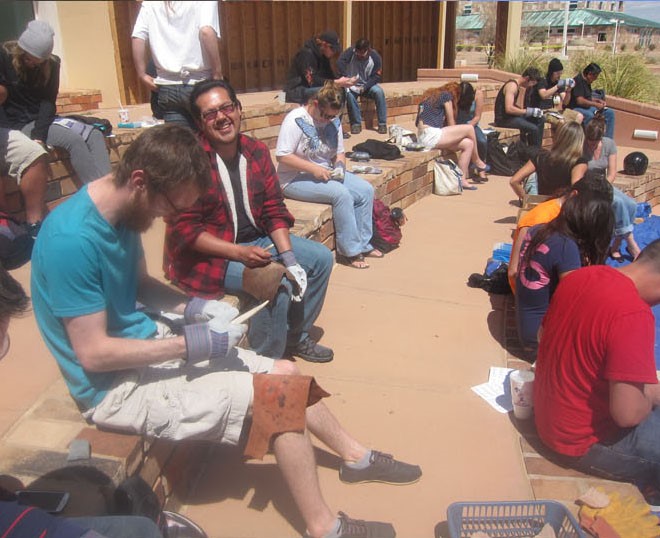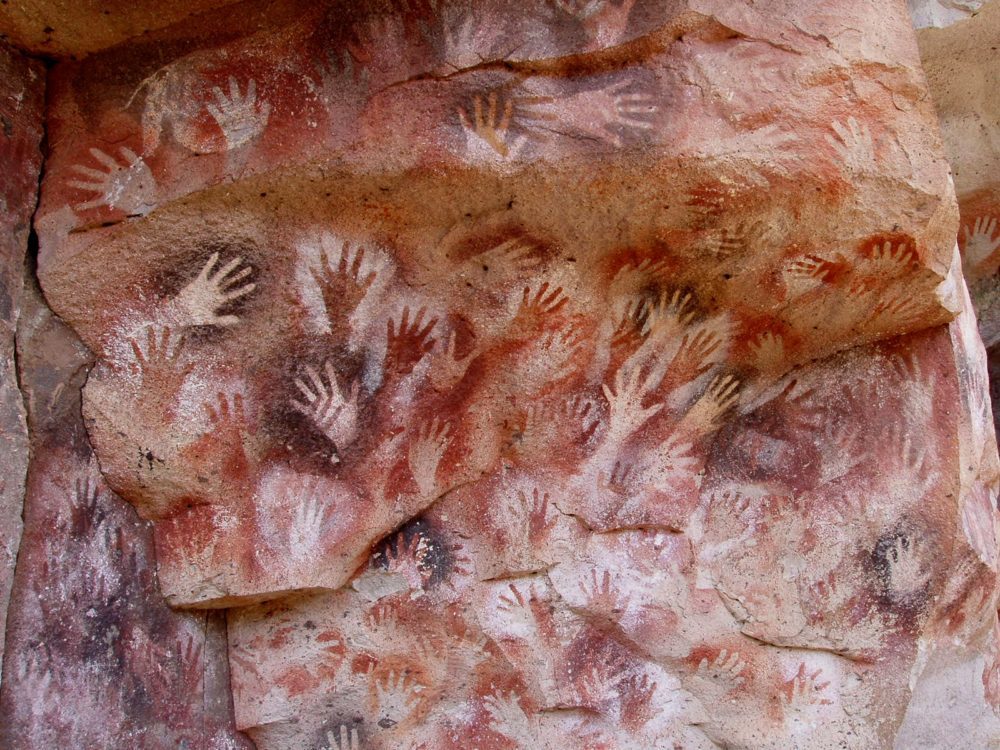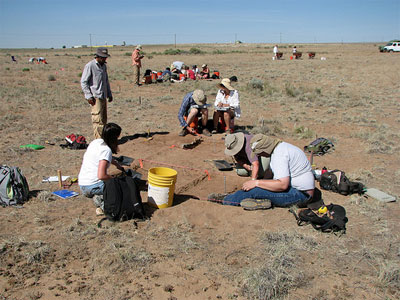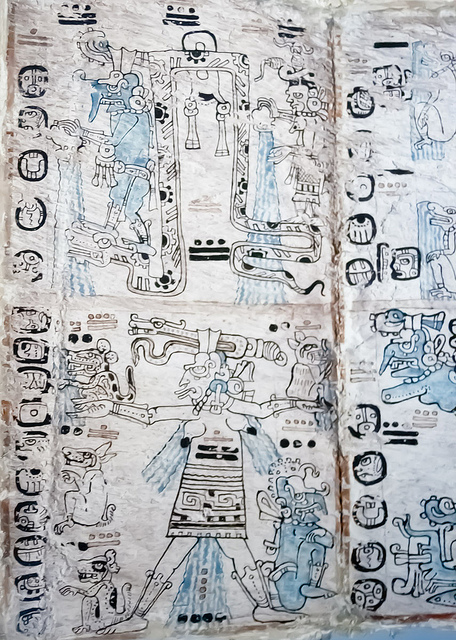Archaeology is only partly about discovering things; for me, archaeology is about thinking about things. —Stephen Lekson
Taking a noon-day break from excavating on Albuquerque’s windswept West Mesa in the summer of 2002, we stretched our legs, cramped from kneeling in a small square pit since 6 am that morning. Someone started a game of hacky sack. Reaching down to retrieve the hack, I saw something black and shiny in the sand. “Gotta be cultural”, I thought. The crew gathered around. We hadn’t found much, despite two straight weeks of digging. Looking closely at the obsidian object, we soon realized that I held in my hand an obsidian Folsom point fragment, a kind of spear tip. The person who last touched the point lived more than 10,000 years ago, at the close of the last ice age. The artifact and its maker belonged to a different geological epoch—the Pleistocene—also known as the ice ages. Ultimately, our excavation would show that a small band of people was hunting a species of giant bison at the edge of a small lake. The point, along with other artifacts recovered at the site was a portal to the past. Within 10 years, the area would be transformed into a modern neighborhood.
One of the deepest of human fantasies is to travel in time to the distant future or the remote past. While we can’t blast back in time through a wormhole or in a DeLorean, we can go anywhere in our minds. This mental time travel may not be unique to humans, but certainly, no other animal is obsessed with the past and future like we are. As “storytelling animals”, we are enchanted by tales of galactic wars of long ago or a future planet ruled by apes. We marvel that because light takes time to travel to our eyes when we gaze up at the stars we may be looking thousands of years into the past. And it’s not just a modern obsession. The ancient Maya, fanatics for calendars and time, inscribed dates well into the 5th millennium A.D. Archaeology is an important sub-field of anthropology. If anthropology only looked at contemporary cultures, we would miss out on a great deal of cultural variability, just as if we only examined WEIRD cultures. Archaeology asks: Who were these ancient people, what were their lives like, and how have they shaped who we are today?
Portals to the Past: Writing and Material Culture
Short of a time machine, one way to know the past is to read what people have put down in writing. Traditionally, the term “history” has been reserved for the last bit of human existence in a few selected parts of the world where writing developed—Western Europe, the Middle East, China, India, and Mesoamerica.
Writing is powerful stuff. The ancient Maya revered the writings of their ancestors and thought that reading ancient texts literally brought their ancestors back to this plane of existence. The venerable astronomer Carl Sagan wrote of the magical quality of books in Cosmos, “One glance at it and you hear the voice of another person, perhaps someone dead for thousands of years. Across the millennia, the author is speaking, clearly and silently, inside your head, directly to you. Writing is perhaps the greatest of human inventions, binding together people, citizens of distant epochs, who never knew one another. Books break the shackles of time―proof that humans can work magic.”
Writing is a relatively recent invention dating back some 5,000 years, and as the burning(s) of the great Royal Library of Alexandria in Egypt attests to a fragile medium. Where written records do not exist, sometimes referred to as prehistory, archaeologists must rely on material culture, physical things that people leave behind.
It is no doubt enriching to read documents written by people who were Cultureliving in the distant past, and there will always be some kinds of information that can only be conveyed by written documents (or film and sound recordings). While writing is an amazing window into the minds of the long-dead, material culture has some advantages over documents. Archaeologists have an old saying: “potsherds don’t lie”. People, on the other hand, are another matter entirely. As anthropologist Roy Rappaport once pointed out, “Any system of communication that employs symbols can also embody lies.” In short, writers always have an agenda—some kind of bias or view of the world that colors their perspective.
Material culture can be quite revealing. In studies of modern refuse, it has been shown that people underestimate the amount of junk food they consume and grossly overestimate how much they recycle.
My master’s thesis advisor, Ed Staski at NMSU, compared people’s reported alcohol consumption to what was in their garbage, and found, not surprisingly, that people make inaccurate estimates about how much they drink. Needless to say, if we relied on what people reported alone, we’d have a skewed understanding of current and past human behavior. Archaeologists don’t study the past, rather, they study the physical remains of the past to understand what happened and why.
Archaeological Methods
Archaeology draws heavily on other sciences including biology, genetics, organic and inorganic chemistry, and physics. These applications of scientific techniques are collectively called archaeological science. An example of archaeological science was recently conducted by archaeologist Patty Crown at the University of New Mexico. Along with Jeffrey Hurst of the Hershey Corporation, Crown discovered the chemical signature for cacao in ancient cylindrical vessels at Chaco Canyon, New Mexico. Not only does this research show that liquid chocolate was in the pots, but given that cacao grows nowhere near New Mexico today, archaeologists can develop and test further questions of trade and exchange between the American Southwest and Mesoamerica to the south more than 1,000 years ago.

Another approach that archaeologists have used to gain insight into past behavior and to test hypotheses is experimental archaeology. Experimental archaeology uses modern-day re-creations to gain insight into the past. For example, archaeologist Bruce Huckell at UNM wanted to know if a certain type of stone spear point could penetrate the hide of a mammoth. When an elephant at the local zoo died, the body was donated. Huckell showed through experimentation that replicated stone points could penetrate the skin of an animal with the approximate skin thickness of a mammoth.
Less dramatic are stone tool replications designed to understand the techniques used to produce stone tools. In my face-to-face courses, I often invite Ron Fields, an archaeologist at the Salinas Pueblo Missions National Monument and expert in stone tools, to show students the basics of making stone tools, also known as flint knapping. Other experiments are conducted on an even more massive scale like this backyard Stonehenge.



